| |
|
|
62.
| From where comes the wind ? |
| |

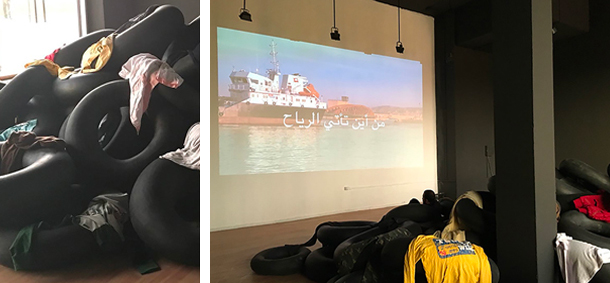
2002-2017, Inner Tubes, clothes, video, size may vary.
Exhibition view from Biennale Agora d'Architecture de Rabat, Culée Creuse, 2018, Rabat.
Courtesy of the artist and Art Front Gallery, Tokyo.
Ed. of 5 + 1 A.P.
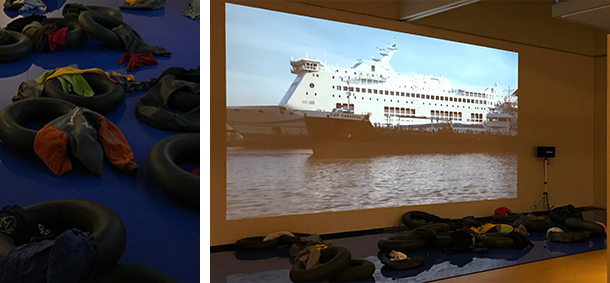
2002-2017, Inner Tubes, clothes, video, size may vary.
Exhibition view from Diaspora Now, Gifu Museum, 2017, Gifu.
Courtesy of the artist and Art Front Gallery, Tokyo
Ed. of 5 + 1 A.P.
This installation expresses a refusal of inequity, injustice and inhuman treatments.
« Where Does the Wind Come From? » calls for an awakening that starts with asking ourselves the right questions.
Studio Fatmi, February 2018
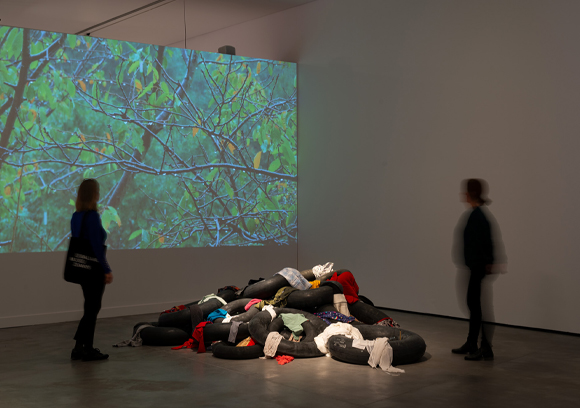
From where comes the wind ?
Exhibition view from In Conversation: The Museum and the Collection, Es Baluard Museu, 2024, Palma.
Courtesy of the artist and Ceysson & Bénétière, Paris.
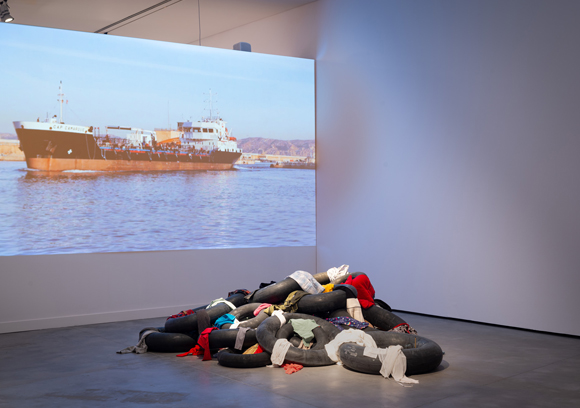
From where comes the wind ?
Exhibition view from In Conversation: The Museum and the Collection, Es Baluard Museu, 2024, Palma.
Courtesy of the artist and Ceysson & Bénétière, Paris.
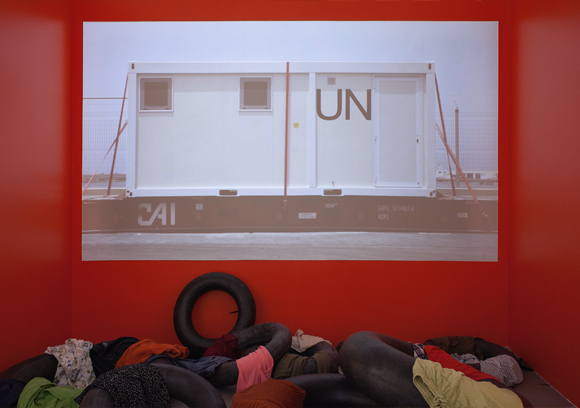
From where comes the wind ?
Exhibition view from Ici sont les dragons 2/3 : Venez comme vous êtes, Maison Populaire, 2019, Montreuil.
Courtesy of the artist and Ceysson & Bénétière, Paris.
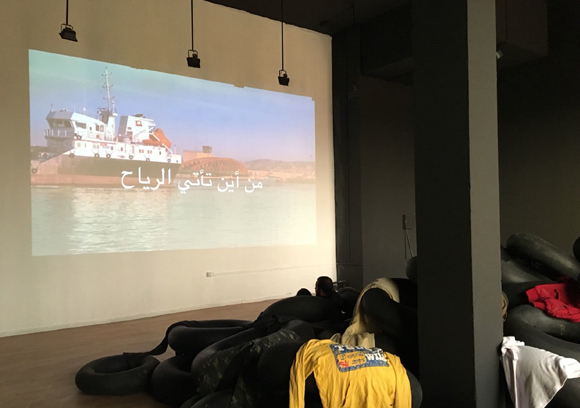
From where comes the wind ?
Exhibition view from Biennale Agora d'Architecture de Rabat, Culée Creuse, 2018, Rabat.
Courtesy of the artist and Art Front Gallery, Tokyo.
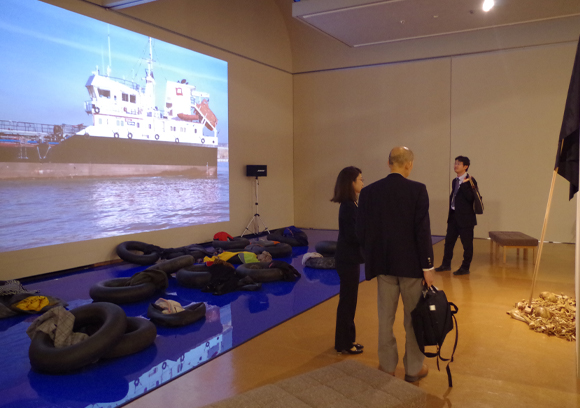
From where comes the wind ?
Exhibition view from Diaspora Now, Gifu Museum, 2017, Gifu.
Courtesy of the artist and Art Front Gallery, Tokyo.
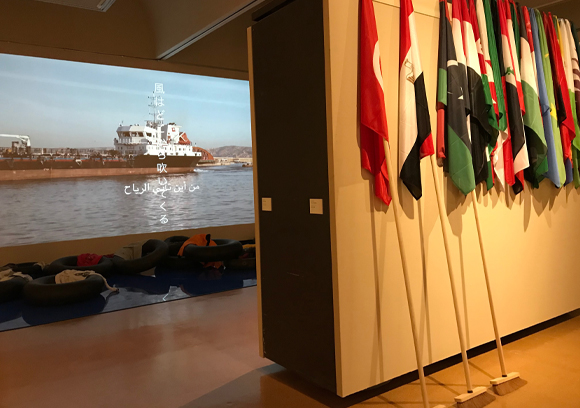
From where comes the wind ?
Exhibition view from Diaspora Now, Gifu Museum, 2017, Gifu.
Courtesy of the artist and Art Front Gallery, Tokyo.
|
|
|
|
|
| Collection of Es Baluard Museu, Palma de Mallorca
|
« D'où vient le vent? » est une installation commencée en 2002 et exposée au Japon en 2017 au Gifu Museum. Elle se compose d'une vidéo, d'une pièce sonore et d'une sculpture s'étalant au sol. La vidéo fait apparaître sur les murs de l'espace d'exposition différents types d'embarcations : paquebots touristiques luxueux et navires commerciaux utilisés pour accueillir des migrants clandestins qui viennent de débarquer, ou dont les bateaux ont fait naufrage en mer. Sur un sol réfléchissant, ont été disposé en désordre des chambres à air noires et des vêtements aux couleurs vives.
L'installation évoque la mort de milliers de migrants chaque année dans les eaux de la Méditerranée, alors que ceux-ci tentent de rejoindre le continent européen, dans l'espoir d'une vie meilleure. Ces déplacements massifs de population sont devenus depuis quelques années un enjeu politique international majeur et connaissent un traitement médiatique intense et régulier. Ils constituent également la préoccupation de nombreux artistes à travers le monde qui préfèrent l'aborder sous ses aspects essentiellement humains et non statistiques, élargissant le thème de l'immigration à celui, universel, de l'exil. Traités dans de nombreuses œuvres dès ses débuts, l'exil, le voyage, la séparation et les rencontres sont des thèmes chers à mounir fatmi, qui se définit lui-même comme « un travailleur immigré ». Le projet collectif et itinérant « Les Pavillons de l’Exil » initié en 2016, dont il est le fondateur, a pour but de réunir des artistes de différentes nationalités autour de cette problématique.
Le titre de l'œuvre formulé sous forme d'interrogation se retrouve également dans le manifeste artistique de mounir fatmi. La question peut paraître innocente. Elle s'interroge sur un phénomène dont la réalité est incontestable, mais qu'il n'est pourtant pas si simple d'expliquer... L'installation met face à face excursions touristiques, libre circulation des marchandises, et contrôle strict des flux migratoires. Elle semble faire également un parallèle entre ces derniers et la circulation des vents autour de la planète, tourbillonnements hasardeux de molécules qui s'organisent cependant en courants repérables, identifiables. L'origine des mouvements de population n'est pas forcément facile à décrire. Les raisons humaines sont multiples et diverses ; elles n'en sont pas moins explicables, à condition de s'y intéresser. La question, au départ innocente, devient gênante et pertinente. Elle met l'adulte en face de ses responsabilités. Elle se transforme en inquiétude et ménage une tension dramatique. Un silence pesant règne autour des vêtements aux couleurs criardes dont les propriétaires sont absents et des cercles noirs se répétant avec insistance, évocation discrète d'une accumulation de tragédies inconcevables et révoltantes. La question posée avec insistance oblige à explorer l'évidence en lui ôtant son caractère de fatalité. Elle exprime un enjeu vital pour l'humanité dans son ensemble. A travers l'installation s'expriment le refus des inégalités, des injustices et des traitements inhumains. « D'où vient le vent? » appelle à une prise de conscience, en commençant par se poser les bonnes questions.
Studio Fatmi, Février 2018.
Installation censurée à la 1ere Agora Biennale d'architecture de Rabat, 2018.
|
|
« Where Does the Wind Come From? » is an installation initiated in 2002 and exhibited at the Gifu Museum, in Japan in 2017. It comprises a video, an audio piece and a sculpture stretched on the floor. The video projects various types of vessels on the walls of the exhibition space: luxurious touristic cruise ships and commercial ships that take in illegal immigrants fresh off their boat or whose boat sunk. On a reflective floor, black bike inner tubes and bright colored clothes are strewn about.
The installation evokes the death of thousands of immigrants every year in the Mediterranean sea, as they try to reach the European continent, hoping for a better life. These massive movements of population have become in recent years a major issue in international politics and are very frequently covered in the media. They also are a subject of preoccupation for many artists around the world who address them under in their essentially human rather than statistical aspects, broadening the subject of immigration to the universal topic of exile. Exile, travel, separation and encounters, questions dear to mounir fatmi, have been treated in many of his works since the beginning of his career, as he himself considers he is an « immigrant worker ». The collective and itinerant project « The Pavilions of Exile », initiated in 2016 by mounir fatmi, aims to bring together artists of different nationalities around these issues.
The title of the piece, formulated as a question, can also be found in mounir fatmi’s artistic manifesto. The question can be perceived as naïve. It poses an interrogation on a phenomenon whose reality isn’t questionable, yet that isn’t easily explained… The installation confronts with one another touristic excursions, the free circulation of merchandise and the strict control of immigration flows. It also seems to create a parallel between the latter and the circulation of winds around the planet, a random whirlpool of molecules that are nevertheless structured into detectable and identifiable currents. The origin of movements of population isn’t easy to describe. There are multiple and diverse human reasons, but these can be explained, if one takes the trouble to show some interest. The originally innocent question thus becomes embarrassing and relevant. It forces adults to face their responsibilities. It transforms itself into anxiety and creates dramatic tension. A heavy silence surrounds these bright colored clothes whose owners are absent, and the stubbornly repeated black circles, a discrete evocation of a great number of inconceivable and revolting tragedies. The question asked with insistence forces us to explore the obvious by removing its aspect of inevitability. It expresses a vital question for humanity as a whole. This installation expresses a refusal of inequity, injustice and inhuman treatments. « Where Does the Wind Come From? » calls for an awakening that starts with asking ourselves the right questions.
Studio Fatmi, February 2018.
|
|
|
|